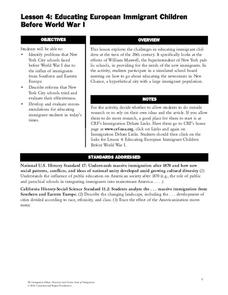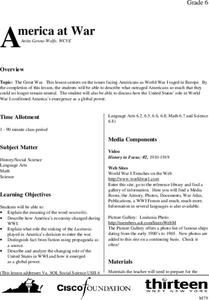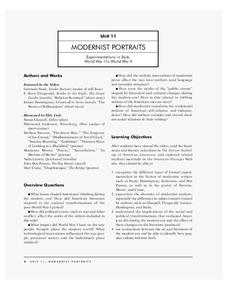Curated OER
Survivor Stories
Trace a survivor's story using a timeline, map skills, poetry and/or prose and photography, and make a visual representation of a survivor's journey through his or her life as a culminating activity for the class and the survivor. This...
Echoes & Reflections
Survivors and Liberators
The end was just the beginning. The period immediately after the end of World War II and the Holocaust is often called "The Return to Life" as survivors looked to reunite and recreate broken families and shattered lives. A two-lesson...
Curated OER
Educating European Immigrant Children Before World War I
Discover the challenges in educating immigrant children at the turn of the 20th century. Reforms that New York City schools used are described here and data is included for your class to analyze, in its evaluation of the effectiveness of...
Curated OER
The U.S. Holocaust Memorial Museum
Ninth graders visit the US Holocaust Museum to witness the actions of the Nazis against the Jews during World War II. A great lesson if you are located near the museum or are planning a trip to the DC area.
National Endowment for the Humanities
The New Order for "Greater East Asia"
Sometimes the New Order becomes synonymous with its implications for European countries, but what about its consequences for East Asia? The final instructional activity in a four-part series teaches scholars about World War II. High...
Curated OER
Jacob Have I Loved
Students examine visual images about the novel, Jacob Have I Loved. They compare pictures from "America from the Great Depression to World War II" that are described in the book and other studies of the Chesapeake Bay. They present their...
US National Archives
WWII: The Pacific 1939-45 – Japan and the Atom Bomb
Though the scientists who developed the atom bomb did not believe it should be used to end World War II, American President Harry S. Truman and British Prime Minister Winston Churchill were of like mind in their decision to drop the bomb...
Smithsonian Institution
Cold War
The Cold War was not necessarily always cold in temperature, but the relationship between the United States and the Soviet Union sure was frigid! Scholars read various passages, view exhibition graphics, and observe an artifact from the...
Constitutional Rights Foundation
Educating European Immigrant Children Before World War I
As if surviving a journey to America wasn't enough of a feat for early 20th century immigrants, they then needed to settle into American life. Learn about the ways New York public education attempted to meet the needs of its students,...
Curated OER
World War II and Propaganda Efforts
Learners define propaganda and list the various propaganda techniques used to influence people. They identify propaganda methods used by the American Government to encourage Americans to support the war effort
Curated OER
War Consumes Europe
How did the world react to Austria's declaration of war? This activity, guided by the McDougall Littell text, World History, has historians examining the beginnings of WWI through cause and effect analysis. Groups reference the text as...
Curated OER
United States Entry into World War I: Some Hypotheses About U.S. Entry
Students take a stand on a hypothesis for U.S. entry into World War I, supported by specific evidence.
Curated OER
Women's Roles in Post World War II
Students discuss the role of women before, during, and after World War II. For this equality lesson, students plan how to make the workforce more equal among men and women after World War II. They research World War II and its effects on...
Curated OER
Women and World War II
Learners determine the influence of World War II on women's roles in society. Students research the answers to questions about how women were able to enter jobs that had not been open to them before the war and how this affected society....
Curated OER
Primary History: Children of World War 2: Growing Up In Wartime
In this history worksheet, students first use the Internet to research and compare schools during World War 2 with those today. Students write a Christmas list of presents for a wartime child in the 1940s.
Curated OER
Facing War
Students visit two sites about World War II. These sites show how war can impact a nation and how people have coped with life during years of war. Particular attention is paid to how the media covers the current war in Iraq.
Curated OER
America at War
Sixth graders examine issues that faced Americans during World War I, discuss role that sinking of the Lusitania had in America's decision to enter the war, and analyze changing role of U.S. during the war and how it emerged as a world...
Curated OER
World War I and Its Consequences
Tenth graders decipher the long and short term causes of World War I. They follow through by studying the history of the present day situation in the Balkans and simulating peace talks with presentations.
PBS
Act of Duty
PBS provides educators with this "Utilization Guide," a four segment program that covers the Civil War, World War I, World War II, the Korean conflict, Vietnam, and the Gulf War. The 42-page packet includes lessons, background...
Teaching English
In Flanders Fields
War is one of the most profound human experiences in history, and is often best depicted in works of art and literature. Introduce class members to the poetry of World War I with this resource that uses John McCrae's "In Flanders Fields"...
Annenberg Foundation
Modernist Portraits
How did literature reflect people's attitudes in post-World War I America? A lesson explores the topic using a variety of activities. Individuals watch and respond to a video; read author biographies and engage in discussion; write...
Curated OER
Maus: Cubing Questioning Strategy
Maus is the text for a postreading activity that has class members using a cubing strategy to analyze, in depth, topics (racism, past and present, forgetting/remembering the Holocaust, representing the Holocaust) associated with Art...
Curated OER
Night: Socratic Questioning Activity
We construct meaning through discussion, so help your readers of Elie Wiesel's work Night with a socratic questioning activity. The strategy is outlined on the first page, and the second page offers some example questions you give to...
Stanford University
Public Housing
The Fair Deal was meant to give Americans after World War II a basic standard of living. Those in public housing often found that promise fell short. Learners consider whether the effort was successful by evaluating images, testimonies,...

























